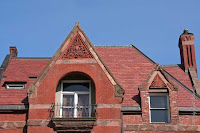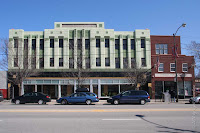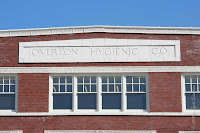






Click on any image for an enlarged view..
Cermak Road Bridge District..
Address: Cermak Road,
predominantly between Grove and Jefferson Sts.
Year Built: 1901-1924
Architect: Various
Date Designated a Chicago Landmark: April 26, 2006..
The Cermak Road Bridge, built in 1906, is the City's last-remaining double leaf Scherzer Rolling Lift Bridge... AND.. The four large industrial buildings, built between 1901 and 1924, framing the Cermak Road Bridge makes for the finest intact, early 20th-century riverfront industrial precinct in Chicago.
These four buildings are:
- Hoyt Building [Nimmons & Fellows, 1909]
- Thomson and Taylor Spice Building [Chatten & Hammond, 1911]
- Western Shade Cloth Building [Lockwood Green & Co., 1924]
- Wendnagel & Co. Warehouse [1901]
These buildings are stunning examples of industrial architecture during the 20th century and illustrates Chicago's importance as the transportation center of the country at that time.."
- Mayor Richard M. Daley.
The oldest building in the district, the Wendnagel & Co. Warehouse, 2120-36 S. Jefferson St. It is built in starkly utilitarian style with little ornamentation. The three later buildings, the Thomson & Taylor Spice Co, Western Shade Cloth Co., and W. H. Hoyt Building, show greater effort towards decorative embellishments.
The Chicago Landmarks website..
The District commemorates the importance of the Chicago River in the economic development of the City and conveys how the interconnected river and rail network made Chicago a national center of commerce. Individually, the buildings are fine examples of early 20th-century industrial architecture, and collectively they represent an almost vanished aspect of Chicago's historical industrial streetscapes...



Cermak Road Bridge - Scherzer Rolling Lift bridge..
In the City of Chicago, where majority of bridges built are trunnion bascule bridges, Scherzer Rolling Lift bridge becomes even more interesting. Designed in 1906 by WIlliam Scherzer, this double leaf rolling lift bascule bridge is the last of its kind in Chicago. In a trunnion bascule bridge, the bridge pivots around a trunnion, with the counterweight concealed below the street. But in a Scherzer rolling lift bridge the counterweight is suspended above the truss, and the bridge rocks backward away from the river.
Location of the above mentioned four buildings..
- W. M. Hoyt Co. bldg. - 465 W. Cermak, Chicago, IL 60616
- Thomson & Taylor Spice Co - 500 W. Cermak
- Western Shade Cloth Co - 2141 S. Jefferson St
- Wendnagel & Co. Warehouse - 2120-36 S. Jefferson St








































